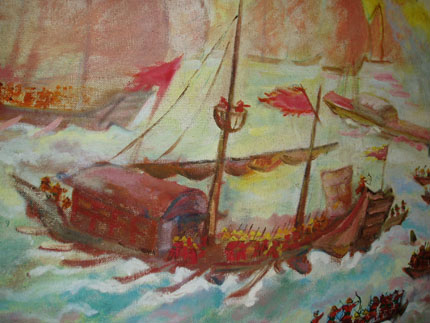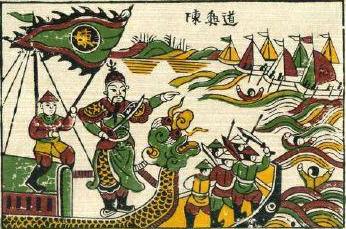
Modern (20th century) depiction of a Chinese vessel from a painting in the Vietnamese National Museum of History, Hanoi (photo by Mark Staniforth courtesy of the Bach Dang River and Van Don Research Team).
Historical background
In 1271 A.D. Kublai Khan, fifth emperor of the Mongol Empire (1260-1294) became founder of the Yuan Dynasty in China (Delgado 2009). On several occasions from 1285 AD onwards, Kublai Khan dispatched armies aboard fleets of ships in an attempt to expand the empire’s hegemony and extend his rule into Southeast Asia (Vietnam). Two highly significant locations associated with these attempted Mongol invasions have been identified – on the Bach Dang River and near the ancient port of Van Don in Vietnam. These are places where historically important naval battles are known to have taken place, in each case resulting in the defeat of the Mongol fleets. Archaeological and material culture remains associated with the fleets and battles have been found at Bach Dang in northern Vietnam where a river/estuary naval battle took place in 1288 AD (Lê et al. 2011).
Vietnamese historical records, including Đại Việt Sử Ký Toàn Thư and An Nam Chi Luoc, as well as Chinese dynasty chronicles such as Yuan Shi, mention the 1288 AD naval battle at Bach Dang. Later accounts of the battle include histories, poems and other sources (Ha & Pham 1968; Hien 2003). The Yuan (Mongol) invading forces initially defeated the Dai Viet on both land and at sea in late 1287 and early 1288 AD (Vu 2008: 170-185). The Mongol invaders under the command of Prince Toghan (son of Kublai Khan) successfully took the capital Thang Long (now Hanoi), but by April 1288 AD found themselves trapped in an empty city without supplies. Shipping was critical in terms of logistics and carrying food for the Yuan forces in the campaign of 1288 and supply ships attempted to reach the trapped Mongol army by way of Halong Bay. According to Đại Việt Sử Ký the Mongol resupply fleet of 70 vessels (commanded by Truong Quang Ho) was attacked and burned by Dai Viet naval forces (commanded by Tran Khanh Du) based in the port of Van Don (today named Cai Lang on Quan Lan Island).
The Mongols abandoned the capital and retreated, but the Dai Viet decided to fight a decisive naval battle with the invaders. The Vietnamese forces, under the command of Tran Hung Dao (1228-1300), lay in wait for the invasion fleet, comprising 18,000 men and 400 vessels commanded by the Mongol general Omar Batur, knowing that they would have to return to China through the estuary at the mouth of the Bach Dang River. The majority of historical sources agree that the principal tactic used by the Dai Viet forces was to prevent the fleet from reaching the open sea and trap them by using hundreds of secretly planted large wooden stakes that had been sharpened to a point and driven into the riverbed at low tide (referred to as stake yards). These stakes were probably covered by water at high tide and were uncovered as the tide fell. This particular technique had also been used in the same general area on two previous occasions in 938 AD, when Ngo Quyen defeated the Southern Han Dynasty army, and in 981 AD, when Le Hoan ordered stakes to be placed to block the Song Dynasty army.
Tran Hung Dao and the Dai Viet troops were victorious and many Mongol ships (perhaps numbering in the hundreds) were burned, lost or captured. The defeat at Bach Dang had serious consequences for the Yuan Dynasty with the loss of many warships and transport vessels, tens of thousands of soldiers as well as several Mongol generals, including Omar Batur, captured or killed. It represented the culmination of the third, and ultimately final, attempt by the Chinese to invade the Dai Viet (in 1257-58, 1283-1285, and 1287-1288 AD). Although many accounts mention the battle, the real story is shrouded in myth and legend. In one of the more persistent accounts, the wooden stakes were tipped with iron or steel, although this has yet to be archaeologically corroborated (Lê 2005). Due to a lack of historical documentation about the battle, an inter-disciplinary study - combining geology, geomorphology, inscriptions, legends and archaeology was first initiated in the late 1950s (Lê et al. 2011).

Modern (20th century) woodblock print showing Tran Hung Dao and some very recent looking vessels in the background. (photo by Mark Staniforth courtesy of the Bach Dang River and Van Don Research Team).
References
Delgado, J.P., 2009. Khubilai Khan's Lost Fleet: In Search of a Legendary Armada, University of California Press. Vancouver/Toronto.
Ha, V. T. & Pham, T. T., 1968. The Resistance War to Against the Yuan Mongol During 13th Century. Social Publishing House, Hanoi.
Hien, L.N., 2003. Three Victories on the Bach Dang River. Nha xuat ban Van hoa-thong tin, Hanoi.
Lê, L.T. 2005. Báo cáo kêt Quả Khảo Sát Thám Sát: Bãi cọc Bạch Đảng Đỏng Vạn Muơi (Report of the Archaeological Exploration and Excavation of the Bach Dang Stake yard in Dong Van Muoi). Internal Report for the Institute of Archaeology, Hanoi.
Lê, L.T., Nguyễn, T.H.M., Pham, C., Staniforth, M., Delgado, J.P., Kimura, J & Sasaki. R. 2011. "Understanding the Bach Dang Battlefield from Recent Research Results" In Staniforth, M. et al. Proceedings on the Asia-Pacific Regional Conference on Underwater Cultural Heritage. Asian Academy for Heritage Management. Manila, Philippines." pp. 77-90.
Vu, H.L, 2008. Mongol invasions in Southeast Asia and their impact on relations between Dai Viet and Champa (1226-1326 C.E.), PhD thesis. University of London. London.
Previous Next
